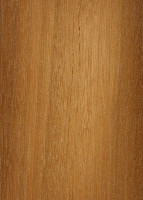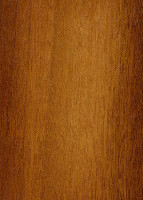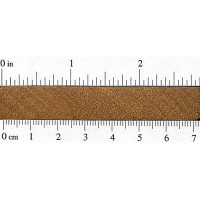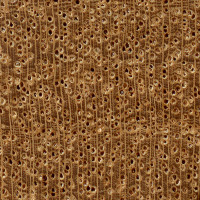 |
Common Name(s): White Meranti, Lauan, Philippine Mahogany Scientific Name: Shorea spp. Distribution: Southeast Asia Tree Size: 130-200 ft (40-60 m) tall, 3-5 ft (1-1.5 m) trunk diameter Average Dried Weight: 37 lbs/ft3 (590 kg/m3) Specific Gravity (Basic, 12% MC): .48, .59 Janka Hardness: 1,050 lbf (4,670 N) Modulus of Rupture: 12,800 lbf/in2 (80.2 MPa) Elastic Modulus: 1,485,000 lbf/in2 (10.24 GPa) Crushing Strength: 6,850 lbf/in2 (47.3 MPa) Shrinkage: Radial: 3.3%, Tangential: 6.9%, Volumetric: 8.9%, T/R Ratio: 2.1 |
Color/Appearance: Heartwood is a pale yellowish-orange when freshly cut, aging to a golden yellow-brown.
Grain/Texture: Has a coarse texture with medium to large pores. Grain is sometimes interlocked. Contains a high level of silica: over .5% of dried weight.
Rot Resistance: Varies between species, though usually reported as being non-durable in regard to decay resistance, and also susceptible to insect attack.
Workability: White Meranti is in and of itself easy to work, but it has a very severe blunting effect on tools due to its high silica content, so carbide-tipped cutters are recommended. Also, interlocked grain can sometimes present problems during planing, and sawn/planed surfaces can be left fuzzy or ragged. Sanding to finer grits will help smooth the wood’s surface, and prepare it for a stain or finish. Glues well.
Odor: No characteristic odor.
Allergies/Toxicity: Although severe reactions are quite uncommon, Meranti in the Shorea genus has been reported to cause eye, throat, and skin irritation. See the articles Wood Allergies and Toxicity and Wood Dust Safety for more information.
Pricing/Availability: Meranti is widely harvested and widely available worldwide. It should be moderately priced despite the fact that it is imported, though some specific species of White Meranti are reported to be endangered.
Sustainability: Meranti is not listed in the CITES Appendices, but many species in the Shorea genus are on the IUCN Red List. The majority of Shorea species are listed as being critically endangered due to a population reduction of over 80% in the past three generations, caused by a decline in its natural range, and exploitation.
Common Uses: Plywood, veneer, boatbuilding, interior furniture, and general construction lumber.
Comments: Sometimes referred to as Lauan, wood in the Shorea genus is very commonly used in southeast Asia, and there is an abundance of variety between the difference species: each with different working properties, appearances, and mechanical strength values.
The five main groupings for Meranti (Lauan) are: Light Red Meranti, Dark Red Meranti, White Meranti, Yellow Meranti, and Balau. The strength and mechanical values listed at the top of this page represent the average of a handful of species within the corresponding group.
Also called Philippine Mahogany, Meranti bears no relation to what is considered to be “true” mahogany in the Swietenia and Khaya genera.
 |
 |
 |
 |




